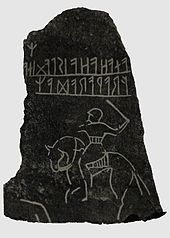Runestone from Möjbro
The rune stone from Möjbro (also Möjebro - Swedish Möjbrostenen ; Rundata U 877) near Hagby in Uppland in Sweden is one of the rather rare rune stones. The rune text remains controversial, but the rune stone bears the artistically outstanding image of a rider, which typologically does not fit the depictions of the Viking Age (800 to 1050 AD) and was probably inspired by continental depictions. Equestrian representations (e.g. on the equestrian stone from Hornhausen and the rune stone from Skokloster (U 678)) are stylistically completely different. The stone is now in the State Historical Museum in Stockholm .
description
A brief text without the name of the Ritzer or the installer is carved into the Möjbrostenen. At the top of the flat, about 2.45 m high block is the atypical horizontal inscription in two parallel rows. Below is the depiction that is one of the best of its kind on a Swedish monument. It shows a rider with a raised, round shield on his left arm and a weapon held high in his right hand. It is the image of a triumphant warrior or herald, reminiscent of horsemen on Roman gravestones. Two smaller animals can be seen under the horse, most likely dogs. The equestrian representation has parallels on the much younger rune stone at Ålum Kirke , the stone U 855 from "Balingsta prästgård" and the rune stone from Skokloster in Uppland .
The inscription can be read from bottom to top to the left. The bottom row reads "FrawaradaR", the top "anahahaislaginaR". The lower sequence of letters has been interpreted as the man's name Frarad, which is possibly shown in the picture. The top row has been designed differently. The reading given by Otto von Friesen is said to be the most likely: “Frarad (rests here). Ane the one-eyed is killed. "
Dating
The dating of the Möjbro stone is uncertain. On the basis of stylistic considerations, more recent research has suggested dating to the Iron Age or the Early Vendel period (5th – 7th centuries) (Holmquist 1976, 566).
context
There are more older runic inscriptions in Sweden from the Migration Period and the earlier Vendel Period than from any other period. Most, however, occur on small objects, especially gold bracteates . Some can be found on erect stones, with which the time of the rune stones began. The number of these rune stones, however, cannot be compared with the enormous number of Viking Age rune stones. About 20 stones with the older runes are known in Sweden from the early period. Norway has around 30 runes carved on burial boxes , rocks and monoliths, while Denmark has no older runes on stone material. The inscriptions on the stones sometimes have a narrative character. A longer Norse runic inscription can be found on the Rö runestone (Bo KJ73 U) discovered in 1919 near Rö, Otterö / Tanum in Bohuslän .
Among the Swedish rune stones from the Pre-Vendel period, the pillar-shaped rune stone from Järsberg (Järsbergstenen) in Värmland should be mentioned. The inscription names the scratcher and the person for whom the stone was set. The stone Vg 63 from Noleby / Fyrunga in Västergötland, which may originally have been in a grave, bears a magical-protective inscription: "a secret writing that comes from the powers that be". At the stone Ög 171 from Skärkind in Östergötland the inscription in the translation should read “Fell-Leuf” (“Leuf, fur trader”).
The inscriptions are sometimes informative. The runic script was used more and more to honor people who deserved to be remembered by posterity. Runes were no longer just for magic.
literature
- Mårten Stenberger : Nordic prehistory. Volume 4: Prehistory of Sweden. Wachholtz, Neumünster 1977, ISBN 3-529-01805-8 , p. 366.
Web links
- Information about the rune stone in the rune project of the University of Kiel
- Hagby 19: 1, the original stand of U 877 - entry in the "Fornsök" database of the Riksantikvarieämbetet (Swedish)
Coordinates: 59 ° 48 ′ 56 ″ N , 17 ° 21 ′ 24.5 ″ E


